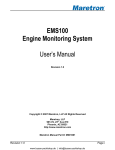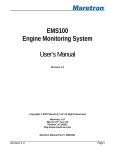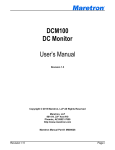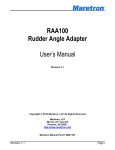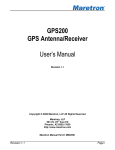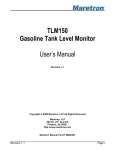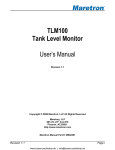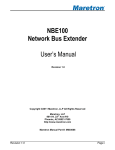Download Maretron EMS100 Automobile Parts User Manual
Transcript
® EMS100 Engine Monitoring System User’s Manual Revision 1.1 Copyright © 2012 Maretron, LLP All Rights Reserved Maretron, LLP 9014 N. 23rd Ave #10 Phoenix, AZ 85021 http://www.maretron.com Maretron Manual Part #: M001601 Revision 1.1 Page i EMS100 User’s Manual Revision History Revision Description 1.0 Original document 1.1 Added information on tachometer connection Added factory default number of flywheel teeth Added information on which fields of transmitted PGN’s are populated Page ii Revision 1.1 ® Table of Contents 1 General ..............................................................................................................................1 1.1 Introduction ................................................................................................................1 1.2 Firmware Revision .....................................................................................................1 1.3 Features ....................................................................................................................1 1.4 Quick Install ...............................................................................................................2 2 Installation ..........................................................................................................................2 2.1 Unpacking the Box ....................................................................................................2 2.2 Choosing a Mounting Location ..................................................................................2 2.3 Mounting the EMS100 ...............................................................................................3 2.4 Connecting the EMS100............................................................................................3 2.4.1 Connecting to NMEA 2000® Interface ........................................................3 2.4.2 Checking Connections................................................................................4 2.5 Configuration .............................................................................................................4 2.5.1 Engine Instance ..........................................................................................4 2.5.2 Drive Trim Gauge Type ..............................................................................5 2.5.3 Drive Trim Sender Type .............................................................................5 2.5.4 Drive Trim Sender Offset ............................................................................5 2.5.5 Boost Pressure Gauge Type ......................................................................5 2.5.6 Boost Pressure Sender Type .....................................................................5 2.5.7 Boost Pressure Sender Offset ....................................................................5 2.5.8 Oil Pressure Gauge Type ...........................................................................6 2.5.9 Oil Pressure Sender Type ..........................................................................6 2.5.10 Oil Pressure Sender Offset ....................................................................6 2.5.11 Water Temperature Gauge Type ...........................................................6 2.5.12 Water Temperature Sender Type ..........................................................6 2.5.13 Water Temperature Sender Offset .........................................................6 2.5.14 Engine Hours .........................................................................................6 2.5.15 Flywheel Teeth ......................................................................................7 2.5.16 NMEA 2000® PGN Enable/Disable ........................................................7 2.5.17 Restore Factory Defaults .......................................................................7 3 Maintenance ......................................................................................................................7 4 Troubleshooting .................................................................................................................8 5 Technical Specifications................................................................................................... 10 5.1 Specifications .......................................................................................................... 10 5.2 Certifications ............................................................................................................ 10 5.3 NMEA 2000® Parameter Group Numbers (PGNs) .................................................. 10 Technical Support ..................................................................................................................... 11 Installation Template ................................................................................................................ 12 Maretron (2 Year) Limited Warranty ......................................................................................... 13 Revision 1.1 Page iii EMS100 User’s Manual Table of Figures Figure 1 – Mounting the EMS100 .............................................................................................. 3 Figure 2 – NMEA 2000® Connector Face Views ....................................................................... 4 Figure 3 – Mounting Surface Template ................................................................................... 12 Table of Appendices Appendix A – NMEA 2000® Interfacing.................................................................................... A1 Page iv Revision 1.1 ® 1 General 1.1 Introduction Congratulations on your purchase of the Maretron EMS100 Engine Monitoring System. Maretron has designed and built your engine monitoring system to the highest standards for years of reliable, dependable, and accurate service. The EMS100 plugs directly into engine wiring harnesses (through the use of a Maretron wiring harness, purchased separately) and converts analog signals such as water temperature and oil pressure to the NMEA 2000® digital interface. Critical engine data is then distributed throughout the vessel over a single cable where it can be monitored by any NMEA 2000® compatible display. The EMS100 is compatible with existing instrument panels and key switches so you don’t need to remove them while upgrading to newer digital technology. For new installations, the EMS100 and a compatible NMEA 2000® display can replace the traditional analog instrument panel. The Maretron EMS100 is designed to operate within the harsh demands of the marine environment. However, no piece of marine electronic equipment can function properly unless installed, configured, and maintained in the correct manner. Please read carefully and follow these instructions for installation, configuration, and usage of the Maretron EMS100 in order to ensure optimal performance. 1.2 Firmware Revision This manual corresponds to EMS100 firmware revision 1.1.1. 1.3 Features The Maretron EMS100 Engine Monitoring System provides the following information on the NMEA 2000® bus. • • • • • • • • • • • • • Tachometer Engine Hours Coolant Water Temperature Engine Oil Pressure Boost Pressure Charging Voltage Drive Trim Fuel Filter Alarm Boost Alarm Coolant Water Level Alarm Engine Oil Pressure Alarm Exhaust (Salt Water Flow) Alarm Coolant Water Temperature Alarm The EMS100 is compatible with these Yanmar engines: Revision 1.1 Page 1 EMS100 User’s Manual • • • • • • GM Series YM Series JH Series LH Series LP Series LY Series The EMS100 has the following additional features: • Waterproof Enclosure and Cable System • Connects to Analog or Digital tachometers • Can Work With or Without Existing Analog Gauges 1.4 Quick Install Installing the Maretron EMS100 Engine Monitoring System involves the following five steps. Please refer to the individual sections for additional details. 1. 2. 3. 4. 5. Unpack the Box (Section 2.1) Choose a Mounting Location (Section 2.2) Mount the EMS100 Engine Monitoring System (Section 2.3) Connect the EMS100 Engine Monitoring System (Section 2.4) Configure the EMS100 Engine Monitoring System (Section 2.5) 2 Installation 2.1 Unpacking the Box When unpacking the box containing the Maretron EMS100, you should find the following items. • • • 1 – EMS100 Engine Monitoring System 1 – EMS100 User’s Manual 1 – Warranty Registration Card If any of these items are missing or damaged, please contact Maretron. 2.2 Choosing a Mounting Location The EMS100 is mounted between the engine and the NMEA 2000® network. Please consider the following when choosing a mounting location. 1. The EMS100 is waterproof, so it can be mounted in a damp or dry location. 2. The orientation is not important, so the EMS100 can be mounted on a horizontal deck, vertical bulkhead, or even upside down if desired. 3. The EMS100 is temperature rated to 55°C (130°F), so it should be mounted away from engines or engine rooms where the operating temperature exceeds the specified limit. Page 2 Revision 1.1 ® 2.3 Mounting the EMS100 Attach the Maretron EMS100 securely to the vessel using bolts or screws (not included) as shown in Figure 1 below. Figure 1 – Mounting the EMS100 2.4 Connecting the EMS100 You connect the EMS100 using a Maretron wiring harness (available separately) which is designed for a particular type of engine. One end of the Maretron wiring harness has two 12pin Deutsch connectors which plug into the two connectors on the end of the EMS100 product enclosure. These connectors are keyed differently, so there is no danger of plugging these in incorrectly. 2.4.1 Connecting to NMEA 2000® Interface The Maretron EMS100 provides a connection to an NMEA 2000® interface through a five pin male connector located on the Maretron wiring harness, which is purchased separately (see Revision 1.1 Page 3 EMS100 User’s Manual Figure 2). You connect the EMS100 to an NMEA 2000® network by plugging the male connector into a female receptacle of the NMEA 2000® network (note the key on the male connector and keyway on the female connector). Be sure the cable is connected securely and that the collar on the cable connector is tightened firmly. The EMS100 is designed such that you can plug or unplug it from an NMEA 2000® network while the power to the network is connected or disconnected. Please follow recommended practices for installing NMEA 2000® network products. Figure 2 – NMEA 2000® Connector Face Views 2.4.2 Checking Connections Once the engine harness connections to the Maretron EMS100 have been completed and the engine harness has been connected to the NMEA 2000® bus, supply power to the engine and check to see that engine information is being properly transmitted by observing an appropriate display. Refer to Section 4, “Troubleshooting”, if no engine information appears, otherwise proceed to Section 2.5 entitled “Configuration”. 2.5 Configuration There are several configurable items within the EMS100. You configure the EMS100 using a Maretron DSM250 display or other NMEA 2000® display unit that is capable of configuring the EMS100. Please refer to the Maretron DSM250 User’s Manual for details. Descriptions of the various configurable items appear in the following sections. 2.5.1 Engine Instance In order to allow display equipment to distinguish between data coming from different engines, the NMEA 2000® network requires that each engine be assigned a unique instance number in the range of 0-252. The EMS100 comes from the factory programmed with an instance number of 0. Conventions for instance numbers for common engine configurations are as follows: • Single Engine = 0 • Dual Engines: Port Engine = 0, Starboard Engine = 1 Page 4 Revision 1.1 ® • Triple Engines: Port Engine = 0, Starboard Engine = 1, Center Engine =2 2.5.2 Drive Trim Gauge Type The EMS100 comes from the factory preprogrammed with the characteristics of drive trim gauge types for supported engines. If the EMS100 is used with an analog drive trim gauge, you must select the correct type of gauge for this setting in order for the data to be displayed correctly. If you have no drive trim gauge present, select the “No Gauge” option for this setting. 2.5.3 Drive Trim Sender Type The EMS100 comes from the factory preprogrammed with the characteristics of drive trim senders for supported engines. If the engine to which you are connecting the EMS100 has a drive trim sender, you must select the correct type of drive trim sender for this setting in order for the data to be displayed correctly. If you have no drive trim sender present, select the “Disabled” option for this setting. 2.5.4 Drive Trim Sender Offset Often, the characteristics of individual drive trim senders vary from their specified values. This setting allows you to apply an offset to the resistance value of the drive trim sender in order to allow you to bring the digital value reported by the EMS100 into agreement with that displayed by the analog gauge. 2.5.5 Boost Pressure Gauge Type The EMS100 comes from the factory preprogrammed with the characteristics of boost pressure gauge types for supported engines. If the EMS100 is used with an analog boost pressure gauge, you must select the correct type of gauge for this setting in order for the data to be displayed correctly. If you have no boost pressure gauge present, select the “No Gauge” option for this setting. 2.5.6 Boost Pressure Sender Type The EMS100 comes from the factory preprogrammed with the characteristics of boost pressure senders for supported engines. If the engine to which you are connecting the EMS100 has a boost pressure sender, you must select the correct type of boost pressure sender for this setting in order for the data to be displayed correctly. If you have no boost pressure sender present, select the “Disabled” option for this setting. 2.5.7 Boost Pressure Sender Offset Often, the characteristics of individual boost pressure senders vary from their specified values. This setting allows you to apply an offset to the resistance value of the boost pressure sender in order to allow you to bring the digital value reported by the EMS100 into agreement with that displayed by the analog gauge. Revision 1.1 Page 5 EMS100 User’s Manual 2.5.8 Oil Pressure Gauge Type The EMS100 comes from the factory preprogrammed with the characteristics of oil pressure gauge types for supported engines. If the EMS100 is used with an analog oil pressure gauge, you must select the correct type of gauge for this setting in order for the data to be displayed correctly. If you have no oil pressure gauge present, select the “No Gauge” option for this setting. 2.5.9 Oil Pressure Sender Type The EMS100 comes from the factory preprogrammed with the characteristics of oil pressure senders for supported engines. If the engine to which you are connecting the EMS100 has a oil pressure sender, you must select the correct type of oil pressure sender for this setting in order for the data to be displayed correctly. If you have no oil pressure sender present, select the “Disabled” option for this setting. 2.5.10 Oil Pressure Sender Offset Often, the characteristics of individual oil pressure senders vary from their specified values. This setting allows you to apply an offset to the resistance value of the oil pressure sender in order to allow you to bring the digital value reported by the EMS100 into agreement with that displayed by the analog gauge. 2.5.11 Water Temperature Gauge Type The EMS100 comes from the factory preprogrammed with the characteristics of water temperature gauge types for supported engines. If the EMS100 is used with an analog water temperature gauge, you must select the correct type of gauge for this setting in order for the data to be displayed correctly. If you have no water temperature gauge present, select the “No Gauge” option for this setting. 2.5.12 Water Temperature Sender Type The EMS100 comes from the factory preprogrammed with the characteristics of water temperature senders for supported engines. If the engine to which you are connecting the EMS100 has a water temperature sender, you must select the correct type of water temperature sender for this setting in order for the data to be displayed correctly. If you have no water temperature sender present, select the “Disabled” option for this setting. 2.5.13 Water Temperature Sender Offset Often, the characteristics of individual water temperature senders vary from their specified values. This setting allows you to apply an offset to the resistance value of the water temperature sender in order to allow you to bring the digital value reported by the EMS100 into agreement with that displayed by the analog gauge. 2.5.14 Engine Hours The EMS100 reports engine hours based on how long the EMS100 has been powered from the engine. The EMS100 comes from the factory preprogrammed with an engine hours reading of 0 hours. If you are installing the EMS100 on an engine that has been in service, or Page 6 Revision 1.1 ® if you have overhauled an engine, you can use this setting to preset the engine hours reading to the desired value. 2.5.15 Flywheel Teeth The EMS100 needs to know the number of flywheel teeth on the engine (or the number of alternator pulses per revolution) in order to correctly calculate engine RPM. Use this setting to program the EMS100 with the number of flywheel teeth or alternator pulses per revolution for the engine the EMS100 is connected to. The factory default value of this parameter is 129. 2.5.16 NMEA 2000® PGN Enable/Disable The EMS100 is capable of transmitting several different kinds of NMEA 2000® messages (or PGNs) associated with engines. You can use this setting to enable or disable transmission of each of these message types. 2.5.17 Restore Factory Defaults This setting will cause all user-programmable settings on the EMS100 to be restored to the values that were in the EMS100 when it was shipped from the factory. 3 Maintenance Regular maintenance is important to ensure continued proper operation of the Maretron EMS100. Perform the following tasks periodically: • • • Clean the unit with a soft cloth. Do not use chemical cleaners as they may remove paint or markings or may corrode the EMS100 enclosure or seals. Ensure that the unit is mounted securely and cannot be moved relative to the mounting surface. If the unit is loose, tighten the mounting screws. Check the security of the connections to the engine wiring harness and re-seat or tighten if necessary. Revision 1.1 Page 7 EMS100 User’s Manual 4 Troubleshooting If you notice unexpected operation of the Maretron EMS100, follow the troubleshooting procedures in this section to remedy simple problems. If these steps do not solve your problem, please contact Maretron Technical Support (refer to Section 0 for contact information). Symptom No engine data visible on NMEA 2000® network. Troubleshooting Procedure Ensure that the NMEA 2000® network is operational by observing displays. You should see information from components besides the ones attached to the EMS100 which verifies an operational NMEA 2000® network. If you don’t see data, try disconnecting the NMEA 2000 connection you made to the EMS100 as something may have been connected incorrectly. Ensure that the Maretron wiring harness is securely connected both to the EMS100 and to the existing engine wiring harness as directed in the instructions supplied with the Maretron wiring harness. Once you are sure that the NMEA 2000 network is operational with a connected EMS100, ensure that the NMEA 2000® connector on the Maretron wiring harness is securely connected to the NMEA 2000® network. Ensure that the ignition switch for engine is turned on. The EMS100 draws the majority of its power from the engine power connection. Ensure that the EMS100 is programmed with an appropriate engine NMEA 2000 instance as described in Section 2.5.1. Incorrect Engine Data Incorrect Tachometer Readings Ensure that all NMEA 2000® messages are enabled (see Section 2.5.16 for details). Ensure that the settings for gauge type, sender type, and number of flywheel teeth are programmed appropriately. Check the values of sender offset programmed into the EMS100. Check the adjustment of the tachometer sensor on the engine. Once the EMS100 is connected, you may need to adjust the spacing between the sensor and the flywheel teeth. Warning: There are no user-serviceable components inside the Maretron EMS100. Opening the EMS100 will expose the sensitive electronic components to adverse environmental conditions that may render the unit inoperative. Please do not open the Page 8 Revision 1.1 ® EMS100, as this will automatically void the warranty. If service is required, please return the unit to an authorized Maretron service location. Revision 1.1 Page 9 EMS100 User’s Manual 5 Technical Specifications As Maretron is constantly improving its products, all specifications are subject to change without notice. Maretron products are designed to be accurate and reliable; however, they should be used only as aids to navigation and not as a replacement for traditional navigation aids and techniques. 5.1 Specifications Parameter Tachometer Engine Hours Oil Pressure Coolant Water Temperature Boost Pressure Drive Trim Angle Charging Voltage Lube Oil Filter Alarm Boost Pressure Alarm Coolant Water Temperature Alarm Oil Pressure Alarm Exhaust (Salt Water Flow) Alarm Clutch Oil Pressure Alarm Diesel Preheat Alarm Type Analog/Digital Input Logged with Key On Analog Input Analog Input Analog Input Analog Input Alarm/Switch Input Alarm/Switch Input Alarm/Switch Input Alarm/Switch Input Alarm/Switch Input Alarm/Switch Input Alarm/Switch Input Alarm/Switch Input Comment Configurable by # of Teeth Stored Indefinitely in Non-Volatile Memory Sensor Voltage Monitor/Sensitize Sensor Voltage Monitor/Sensitize Sensor Voltage Monitor/Sensitize Sensor Voltage Monitor/Sensitize 5.2 Certifications Parameter NMEA 2000® Maritime Navigation and Radiocommunication Equipment & Systems FCC and CE Mark Comment Level A IEC 60945 Electromagnetic Compatibility 5.3 NMEA 2000® Parameter Group Numbers (PGNs) Description Periodic Data PGNs Response to Requested PGNs Protocol PGNs Maretron Proprietary PGNs Page 10 PGN # 127488 127489 126464 126996 126998 059392 059904 060416 060160 060928 065240 126208 128720 PGN Name Engine Parameters, Rapid Update Engine Parameters, Dynamic PGN List (Transmit and Receive) Product Information Configuration Information ISO Acknowledge ISO Request ISO Transport Protocol, Connection Management ISO Transport Protocol, Data Transfer ISO Address Claim ISO Address Command NMEA Configuration Default Rate 10 times/second 1 time/second N/A N/A N/A N/A N/A N/A N/A N/A N/A N/A Revision 1.1 ® Electrical Parameter Operating Voltage Power Consumption Load Equivalence Number (LEN) Reverse Battery Protection Load Dump Protection Value 9 to 16 Volts <150mA 1 Yes Yes Comment DC Voltage From Battery NMEA 2000® Spec. (1LEN = 50 mA) Indefinitely Energy Rated per SAE J1113 Mechanical Parameter Value 5” x 4.5” x 1.25” 12 oz. Size Weight Comment Excluding Wiring Harness Excluding Wiring Harness Environmental Parameter IEC 60954 Classification Degree of Protection Operating Temperature Storage Temperature Relative Humidity Vibration Rain and Spray Solar Radiation Corrosion (Salt Mist) Electromagnetic Emission Electromagnetic Immunity Safety Precautions Value Exposed IP68 -25°C to 55°C -40°C to 70°C 93%RH @40° per IEC60945-8.2 2-13.2Hz @ ±1mm, 13.2-100Hz @ 7m/s2 per IEC 60945-8.7 12.5mm Nozzle @ 100liters/min from 3m for 30min per IEC 60945-8.8 Ultraviolet B, A, Visible, and Infrared per IEC 60945-8.10 4 times 7days @ 40°C, 95%RH after 2 hour Salt Spray Per IEC 60945-8.12 Conducted and Radiated Emission per IEC 60945-9 Conducted, Radiated, Supply, and ESD per IEC 60945-10 Dangerous Voltage, Electromagnetic Radio Frequency per IEC 60945-12 Technical Support If you require technical support for Maretron products, you can reach us in any of the following ways: Telephone: Fax: E-mail: World Wide Web: Mail: Revision 1.1 1-866-550-9100 1-602-861-1777 [email protected] http://www.maretron.com Maretron, LLP Attn: Technical Support 9014 N. 23rd Ave Suite 10 Phoenix, AZ 85021 USA Page 11 EMS100 User’s Manual Installation Template Please check the dimensions before using the following diagram as a template for drilling the mounting holes because the printing process may have distorted the dimensions. 4.0” Figure 3 – Mounting Surface Template Page 12 Revision 1.1 ® Maretron (2 Year) Limited Warranty Maretron warrants the EMS100 to be free from defects in materials and workmanship for two (2) years from the date of original purchase. If within the applicable period any such products shall be proved to Maretron’s satisfaction to fail to meet the above limited warranty, such products shall be repaired or replaced at Maretron’s option. Purchaser's exclusive remedy and Maretron’s sole obligation hereunder, provided product is returned pursuant to the return requirements below, shall be limited to the repair or replacement, at Maretron’s option, of any product not meeting the above limited warranty and which is returned to Maretron; or if Maretron is unable to deliver a replacement that is free from defects in materials or workmanship, Purchaser’s payment for such product will be refunded. Maretron assumes no liability whatsoever for expenses of removing any defective product or part or for installing the repaired product or part or a replacement therefore or for any loss or damage to equipment in connection with which Maretron’s products or parts shall be used. With respect to products not manufactured by Maretron, Maretron’s warranty obligation shall in all respects conform to and be limited to the warranty actually extended to Maretron by its supplier. The foregoing warranties shall not apply with respect to products subjected to negligence, misuse, misapplication, accident, damages by circumstances beyond Maretron’s control, to improper installation, operation, maintenance, or storage, or to other than normal use or service. THE FOREGOING WARRANTIES ARE EXPRESSLY IN LIEU OF AND EXCLUDES ALL OTHER EXPRESS OR IMPLIED WARRANTIES, INCLUDING BUT NOT LIMITED TO THE IMPLIED WARRANTIES OF MERCHANTABILITY AND OF FITNESS FOR A PARTICULAR PURPOSE. Statements made by any person, including representatives of Maretron, which are inconsistent or in conflict with the terms of this Limited Warranty, shall not be binding upon Maretron unless reduced to writing and approved by an officer of Maretron. IN NO CASE WILL MARETRON BE LIABLE FOR INCIDENTAL OR CONSEQUENTIAL DAMAGES, DAMAGES FOR LOSS OF USE, LOSS OF ANTICIPATED PROFITS OR SAVINGS, OR ANY OTHER LOSS INCURRED BECAUSE OF INTERRUPTION OF SERVICE. IN NO EVENT SHALL MARETRON’S AGGREGATE LIABILITY EXCEED THE PURCHASE PRICE OF THE PRODUCT(S) INVOLVED. MARETRON SHALL NOT BE SUBJECT TO ANY OTHER OBLIGATIONS OR LIABILITIES, WHETHER ARISING OUT OF BREACH OF CONTRACT OR WARRANTY, TORT (INCLUDING NEGLIGENCE), OR OTHER THEORIES OF LAW WITH RESPECT TO PRODUCTS SOLD OR SERVICES RENDERED BY MARETRON, OR ANY UNDERTAKINGS, ACTS OR OMISSIONS RELATING THERETO. Maretron does not warrant that the functions contained in any software programs or products will meet purchaser’s requirements or that the operation of the software programs or products will be uninterrupted or error free. Purchaser assumes responsibility for the selection of the software programs or products to achieve the intended results, and for the installation, use and results obtained from said programs or products. No specifications, samples, descriptions, or illustrations provided Maretron to Purchaser, whether directly, in trade literature, brochures or other documentation shall be construed as warranties of any kind, and any failure to conform with such specifications, samples, descriptions, or illustrations shall not constitute any breach of Maretron’s limited warranty. Warranty Return Procedure: To apply for warranty claims, contact Maretron or one of its dealers to describe the problem and determine the appropriate course of action. If a return is necessary, place the product in its original packaging together with proof of purchase and send to an Authorized Maretron Service Location. You are responsible for all shipping and insurance charges. Maretron will return the replaced or repaired product with all shipping and handling prepaid except for requests requiring expedited shipping (i.e. overnight shipments). Failure to follow this warranty return procedure could result in the product’s warranty becoming null and void. Maretron reserves the right to modify or replace, at its sole discretion, without prior notification, the warranty listed above. To obtain a copy of the then current warranty policy, please go to the following web page: http://www.maretron.com/company/warranty.php Revision 1.1 Page 13 EMS100 User’s Manual This page intentionally left blank Page 14 Revision 1.1 ® Appendix A – NMEA 2000® Interfacing Note: For integer values, the most positive three values are reserved; e.g., for 8-bit unsigned integers, the values 0xFD, 0xFE, 0xFF are reserved, and for 8-bit signed integers, the values 0x7D, 0x7E, 0x7F are reserved. The most positive value (0xFF and 0x7F, respectively, for the 8-bit examples) represents Data Not Available. EMS100 NMEA 2000® Periodic Data Transmitted PGNs PGN 127488 – Engine Parameters, Rapid Update The EMS100 uses this PGN to transmit rapidly changing engine data. Field 1: Engine Instance – (8-bit unsigned integer) This field indicates the particular engine for which this data applies. A single engine will have an instance of 0. Engines in multi-engine boats will be numbered starting at 0 at the bow of the boat incrementing to n going in towards the stern of the boat. For engines at the same distance from the bow are stern, the engines are numbered starting from the port side and proceeding towards the starboard side. 2: Engine Speed – (16-bit unsigned integer) This field indicates the rotational speed of the engine in units of ¼ RPM. 3: Engine Boost Pressure – (16-bit unsigned integer) This field indicates the turbocharger boost pressure in units of 100 Pa. 4: Engine tilt/trim – (8-bit signed integer) This field indicates the tilt or trim (positive or negative) of the engine in units of 1 percent. 5: Reserved – (16 bits) This field is reserved by NMEA; therefore, the EMS100 sets all bits to a logic 1. PGN 127489 – Engine Parameters, Dynamic The EMS100 uses this PGN to transmit more slowly changing engine data. Field 1: Engine Instance – (8-bit unsigned integer) This field indicates the particular engine for which this data applies. A single engine will have an instance of 0. Engines in multi-engine boats will be numbered starting at 0 at the bow of the boat incrementing to n going in towards the stern of the boat. For engines at the same distance from the bow are stern, the engines are numbered starting from the port side and proceeding towards the starboard side. 2: Engine Oil Pressure – (16-bit unsigned integer) This field indicates the oil pressure of the engine in units of 100 Pa. 3: Engine Oil Temperature – (16-bit unsigned integer) This field indicates the oil temperature of the engine in units of 0.1°K. The EMS100 does not provide a value for this field. 4: Engine Temperature – (16-bit unsigned integer) This field indicates the temperature of the engine coolant in units of 0.1°K. 5: Alternator Potential – (16-bit signed integer) This field indicates the alternator voltage in units of 0.01V. Revision 1.1 Page A1 EMS100 User’s Manual 6: Fuel Rate – (16-bit signed integer) This field indicates the fuel consumption rate of the engine in units of 0.0001 cubic meters / hour. The EMS100 does not provide a value for this field. 7: Total Engine Hours – (32-bit unsigned integer) This field indicates the cumulative runtime of the engine in units of 1 second. 8: Engine Coolant Pressure – (16-bit unsigned integer) This field indicates the pressure of the engine coolant in units of 100 Pa. The EMS100 does not provide a value for this field. 9: Fuel Pressure – (16-bit unsigned integer) This field indicates the pressure of the engine fuel in units of 1000 Pa. The EMS100 does not provide a value for this field. 10: Reserved – (8 bits) This field is reserved by NMEA; therefore, the EMS100 sets all bits to a logic 1. 11: Engine Discrete Status 1 – (16 bits) This field indicates warning conditions of the engine with the following bit assignments (value of 1 indicates warning present): Bit 0: Check Engine - The EMS100 always transmits a value of 0 for this field. Bit 1: Over Temperature Bit 2: Low Oil Pressure Bit 3: Low Oil Level - The EMS100 always transmits a value of 0 for this field. Bit 4: Low Fuel Pressure - The EMS100 always transmits a value of 0 for this field. Bit 5: Low System Voltage - The EMS100 always transmits a value of 0 for this field. Bit 6: Low Coolant Level Bit 7: Water Flow Bit 8: Water in Fuel Bit 9: Charge Indicator Bit 10: Preheat Indicator Bit 11: High Boost Pressure Bit 12: Rev Limit Exceeded - The EMS100 always transmits a value of 0 for this field. Bit 13: EGR System - The EMS100 always transmits a value of 0 for this field. Bit 14: Throttle Position Sensor - The EMS100 always transmits a value of 0 for this field. Bit 15: Emergency Stop Mode 12: Engine Discrete Status 2 – (16 bits) This field indicates warning conditions of the engine with the following bit assignments (value of 1 indicates warning present): Bit 0: Warning Level 1 - The EMS100 always transmits a value of 0 for this field. Bit 1: Warning Level 2 - The EMS100 always transmits a value of 0 for this field. Bit 2: Power Reduction - The EMS100 always transmits a value of 0 for this field. Bit 3: Maintenance Needed - The EMS100 always transmits a value of 0 for this field. Bit 4: Engine Comm Error - The EMS100 always transmits a value of 0 for this field. Bit 5: Sub or Secondary Throttle - The EMS100 always transmits a value of 0 for this field. Page A2 Revision 1.1 ® Bit 6: Neutral Start Protect - The EMS100 always transmits a value of 0 for this field. Bit 7: Engine Shutting Down - The EMS100 always transmits a value of 0 for this field. Bit 8-15: These bits are reserved and should be masked when read 13: Percent Engine Load – (8-bit signed integer) This field indicates the percent load of the engine in units of 1 percent. The EMS100 does not provide a value for this field. 14: Percent Engine Torque – (8-bit signed integer) This field indicates the percent torque of the engine in units of 1 percent. The EMS100 does not provide a value for this field. Revision 1.1 Page A3





















